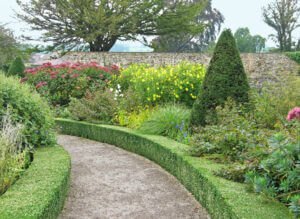April is a busy time for anybody with an interest in their gardens. Whether you’re preparing for a big garden design project as the warmer months tick slowly toward us, or you’re rummaging around for last year’s seed packets and hidden bulbs; you’re going to find yourself spending some time in the spring sunshine this month. It’s a time of great activity both in the soil and the treetops, you’ll see new wildlife beginning to appear and your bird tables will be put to the test over the next few weeks!
Proper preparation prevents poor performance
At the risk of sounding like a science teacher by quoting the above, it really is a great mantra to stick by when you’ve got your fingers in the soil. Check for damage from the cold weather as soon as you get the chance, you’re looking for frost damage from snow, ice and cool temperatures. If you spot any damaged plants then make sure to remove them as soon as possible, they can become second homes for insects, pests and fungi that can be dangerous to your other greenery.
When you’re thinking about planting your spring crop, make sure that you give the soil long enough to dry out before you begin. Squeeze clumps of soil from around your flowerbeds between your hands, when it begins to crumble and fall through your fingers then it’s dry enough. If you’re not quite there yet, wait a week or so and pray for a dry April.
If you haven’t started your own compost pile yet, now is as good a time as any. Use all of those damaged plants and that pile of weeds that you tackled last weekend, get them into a composting bin and mix in equal amounts of brown material to brew the perfect mix. This time next year you’ll be praising your forethought as you count the pennies that you save on fertiliser.
April planting guide: bulbs, bulbs and more bulbs
You’ll probably notice that both your neighbour and the local park have blossomed into colour whilst yours might still be looking a bit tired. The secret is selective and strategic bulb planting, which should normally be undertaken before the first frost if you want to yield results in spring. This includes daffodils, tulips and crocus.
The art of good bulb-work could take up a whole article in itself, and in all likelihood probably will, but there are some basic tips that you can jot down for now.
- Check new bulbs aren’t damaged or soft
- Plant new bulbs within a week of purchase
- Ensure bulbs have good drainage and sunshine
- Always plant bulbs with its top facing skyward
- Ensure there are no air spaces around a planted bulb
- Keep surrounding soil and compost moist during growth
- Wrap vulnerable bulb-ed areas with bubble wrap for winter
If you can’t wait for the winter months to get stuck into bulbs, there are several summer-flowering varieties to try including Lilies, Gladiolus and Ranunculus.
April flowering trees
With the splash of blossoming trees on view everywhere last spring, many people began to consider ways to bring that artwork into their own gardens. If you don’t have the time or energy to planting and cultivating and would rather enjoy the colour and fragrance of spring-flowering trees without having to wait, you can have young flowering trees planted directly into your garden. When chosen and implemented correctly, trees of any size can transform your garden completely.
Some of the most sought-after and beautiful trees that will turn heads this spring include Kursar with it’s incredible pink depth of blossom, the Beni-yutaka’s journey from deep pink bud to washed pale disks and La Paloma’s white and chocolate-brown early autumnal feel.



1 Comment. Leave new
When does the Blog about the National Trust etc gardens go up?